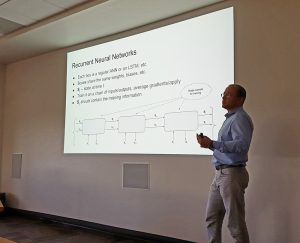As part of a Department of Homeland Security-funded summer research team program at the Coastal Resilience Center (CRC), Principal Investigator Brian Blanton at the University of North Carolina at Chapel Hill hosted Dr. Anton Bezuglov, an Associate Professor of Computer Science at Benedict College in Columbia, S.C. The summer program focuses on matching researchers and students from minority-serving institutions with CRC researchers.
Dr. Bezuglov develops and applies methods in expert systems, computer learning models and other decision support systems, in areas such as traffic modeling. Along with Benedict student Reinaldo Santiago, he worked to improve the computing speed of ADCIRC storm surge modeling. Dr. Bezuglov spoke about his work and how he hopes it will impact CRC research.
Coastal Resilience Center: Could you tell us a little about your research background?

Dr. Anton Bezuglov: Frankly, I haven’t been doing much research until recently. For the last seven or eight years, I have been working at Benedict College as a teacher. I just had a paper that was recently published [“Short-term freeway traffic parameter prediction: Application of grey system theory models”]. But my research interests are in machine learning and data mining and artificial neural networks.
CRC: It seems that freeway traffic could have some application to coastal transportation.
Dr. Bezuglov: It could be, yes. As a computer science professor, I have not focused on one application area. I have models that I can use – like artificial neural networks or grey models – and I could apply them for multiple applications. In the case of CRC, [PI Dr. Brian Blanton] is the domain expert in storm surge prediction, which we are doing right now.
What we are trying to do is to make a model for storm surge prediction, and the model is based on six hurricane parameters – the coordinates of the hurricane center, the speed and a few others. The output [we are trying to recreate] is actually the storm surge at 10 locations along the coast. We have the [expected] output, what the ADCIRC model predicts, and we try to match the ADCIRC output and our [alternate] model’s output.
CRC: So, you are finding another way through these models to replicate what ADCIRC predicts.
Dr. Bezuglov: That’s correct. This is not a new approach; there are a few publications that show that people have actually done this. But they usually have these six inputs matched to one [expected] output, to storm surge prediction in one location. What we are trying to do is have one model that will output storm surge predictions at 10 locations simultaneously.
CRC: If you could explain that concept to an end user, somebody who is an emergency manager in a coastal community, what is the computer modeling that you’re doing? How would the modeling that you’re doing impact people preparing for a storm?
Dr. Bezuglov: The best benefit from what I can see is that compared to ADCIRC, this neural network model is much faster and cheaper in terms of computation. … It took [Dr. Blanton] a few hours to generate results [with ADCIRC’s models]. For our neural network model it should take a fraction of a second; currently, the average accuracy is at approximately 3 inches.
An artificial neural network is a non-parametric model that consists of artificial neurons. These neurons are over-simplified models of biological neurons. The output of an artificial neuron is essentially a weighted sum of its inputs and a nonlinear function. The important thing is that one can replicate any nonlinear function if there are a sufficient number of these neurons.
These models are very flexible – they can model any process by learning from generated data. However, they need very large datasets to be trained. In the case of our project, Dr. Blanton had to generate data for 324 synthetic hurricanes (which would equal approximately 1,000 years of observed storms).

CRC: What sort of future paths would you see for this kind of work?
Dr. Bezuglov: I’m exploring a few ways to incorporate time [as a variable]. So far the model has no memory and the output is determined only by the inputs, just like a calculator. I am thinking we can try Recurrent Neural Networks (RNN) to improve the accuracy.
CRC: Do you think that working with neural networks to model storms would impact your future work as a professor?
Dr. Bezuglov: Hopefully so, because we have discussed plans with [Dr. Blanton] for future research. Hopefully, we can apply for follow-up funding, and hopefully, we’ll collaborate.
Dr. Bezuglov’s final presentation can be viewed here.
